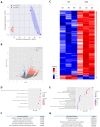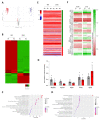Decoupling of mRNA and Protein Expression in Aging Brains Reveals the Age-Dependent Adaptation of Specific Gene Subsets
- PMID: 36831282
- PMCID: PMC9954025
- DOI: 10.3390/cells12040615
Decoupling of mRNA and Protein Expression in Aging Brains Reveals the Age-Dependent Adaptation of Specific Gene Subsets
Abstract
During aging, changes in gene expression are associated with a decline in physical and cognitive abilities. Here, we investigate the connection between changes in mRNA and protein expression in the brain by comparing the transcriptome and proteome of the mouse cortex during aging. Our transcriptomic analysis revealed that aging mainly triggers gene activation in the cortex. We showed that an increase in mRNA expression correlates with protein expression, specifically in the anterior cingulate cortex, where we also observed an increase in cortical thickness during aging. Genes exhibiting an aging-dependent increase of mRNA and protein levels are involved in sensory perception and immune functions. Our proteomic analysis also identified changes in protein abundance in the aging cortex and highlighted a subset of proteins that were differentially enriched but exhibited stable mRNA levels during aging, implying the contribution of aging-related post- transcriptional and post-translational mechanisms. These specific genes were associated with general biological processes such as translation, ribosome assembly and protein degradation, and also important brain functions related to neuroplasticity. By decoupling mRNA and protein expression, we have thus characterized distinct subsets of genes that differentially adjust to cellular aging in the cerebral cortex.
Keywords: aging; brain; cortex; mRNA; protein; proteome; transcriptome.
Conflict of interest statement
The authors have declared no competing interests.
Figures





Similar articles
-
Reduced proteasome activity in the aging brain results in ribosome stoichiometry loss and aggregation.Mol Syst Biol. 2020 Jun;16(6):e9596. doi: 10.15252/msb.20209596. Mol Syst Biol. 2020. PMID: 32558274 Free PMC article.
-
An atlas of the aging mouse proteome reveals the features of age-related post-transcriptional dysregulation.Nat Commun. 2024 Oct 2;15(1):8520. doi: 10.1038/s41467-024-52845-x. Nat Commun. 2024. PMID: 39353907 Free PMC article.
-
Transcript and protein expression decoupling reveals RNA binding proteins and miRNAs as potential modulators of human aging.Genome Biol. 2015 Feb 22;16(1):41. doi: 10.1186/s13059-015-0608-2. Genome Biol. 2015. PMID: 25853883 Free PMC article.
-
Insights into the regulation of protein abundance from proteomic and transcriptomic analyses.Nat Rev Genet. 2012 Mar 13;13(4):227-32. doi: 10.1038/nrg3185. Nat Rev Genet. 2012. PMID: 22411467 Free PMC article. Review.
-
Finding Correlations Between mRNA and Protein Levels in Leishmania Development: Is There a Discrepancy?Front Cell Infect Microbiol. 2022 Jul 12;12:852902. doi: 10.3389/fcimb.2022.852902. eCollection 2022. Front Cell Infect Microbiol. 2022. PMID: 35903202 Free PMC article. Review.
Cited by
-
A temporal cortex cell atlas highlights gene expression dynamics during human brain maturation.Nat Genet. 2024 Dec;56(12):2718-2730. doi: 10.1038/s41588-024-01990-6. Epub 2024 Nov 20. Nat Genet. 2024. PMID: 39567748 Free PMC article.
-
Involvement of Inheritance in Determining Telomere Length beyond Environmental and Lifestyle Factors.Aging Dis. 2023 Nov 5;15(6):2470-2490. doi: 10.14336/AD.2023.1023. Aging Dis. 2023. PMID: 37962459 Free PMC article. Review.
-
Regulating translation in aging: from global to gene-specific mechanisms.EMBO Rep. 2024 Dec;25(12):5265-5276. doi: 10.1038/s44319-024-00315-2. Epub 2024 Nov 19. EMBO Rep. 2024. PMID: 39562712 Free PMC article. Review.
-
Brain aging shows nonlinear transitions, suggesting a midlife "critical window" for metabolic intervention.Proc Natl Acad Sci U S A. 2025 Mar 11;122(10):e2416433122. doi: 10.1073/pnas.2416433122. Epub 2025 Mar 3. Proc Natl Acad Sci U S A. 2025. PMID: 40030017 Free PMC article.
-
Cell type-specific gene expression dynamics during human brain maturation.bioRxiv [Preprint]. 2024 May 17:2023.09.29.560114. doi: 10.1101/2023.09.29.560114. bioRxiv. 2024. Update in: Nat Genet. 2024 Dec;56(12):2718-2730. doi: 10.1038/s41588-024-01990-6. PMID: 37808657 Free PMC article. Updated. Preprint.
References
Publication types
MeSH terms
Substances
Grants and funding
LinkOut - more resources
Full Text Sources
Molecular Biology Databases

